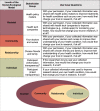Building trust in research through information and intent transparency with health information: representative cross-sectional survey of 502 US adults
- PMID: 35699571
- PMCID: PMC9382374
- DOI: 10.1093/jamia/ocac084
Building trust in research through information and intent transparency with health information: representative cross-sectional survey of 502 US adults
Abstract
Objective: Participation in healthcare research shapes health policy and practice; however, low trust is a barrier to participation. We evaluated whether returning health information (information transparency) and disclosing intent of data use (intent transparency) impacts trust in research.
Materials and methods: We conducted an online survey with a representative sample of 502 US adults. We assessed baseline trust and change in trust using 6 use cases representing the Social-Ecological Model. We assessed descriptive statistics and associations between trust and sociodemographic variables using logistic and multinomial regression.
Results: Most participants (84%) want their health research information returned. Black/African American participants were more likely to increase trust in research with individual information transparency (odds ratio (OR) 2.06 [95% confidence interval (CI): 1.06-4.34]) and with intent transparency when sharing with chosen friends and family (3.66 [1.98-6.77]), doctors and nurses (1.96 [1.10-3.65]), or health tech companies (1.87 [1.02-3.40]). Asian, Native American or Alaska Native, Native Hawaiian or Pacific Islander, Multirace, and individuals with a race not listed, were more likely to increase trust when sharing with health policy makers (1.88 [1.09-3.30]). Women were less likely to increase trust when sharing with friends and family (0.55 [0.35-0.87]) or health tech companies (0.46 [0.31-0.70]).
Discussion: Participants wanted their health information returned and would increase their trust in research with transparency when sharing health information.
Conclusion: Trust in research is influenced by interrelated factors. Future research should recruit diverse samples with lower baseline trust levels to explore changes in trust, with variation on the type of information shared.
Keywords: health informatics; patient-reported outcomes; recruitment; transparency; trust.
© The Author(s) 2022. Published by Oxford University Press on behalf of the American Medical Informatics Association. All rights reserved. For permissions, please email: journals.permissions@oup.com.
Figures






Similar articles
-
Returning study results to research participants: Data access, format, and sharing preferences.Int J Med Inform. 2023 Feb;170:104955. doi: 10.1016/j.ijmedinf.2022.104955. Epub 2022 Dec 13. Int J Med Inform. 2023. PMID: 36565546 Free PMC article.
-
Americans' Trust in Health Information Sources: Trends and Sociodemographic Predictors.Am J Health Promot. 2019 Nov;33(8):1187-1193. doi: 10.1177/0890117119861280. Epub 2019 Jul 23. Am J Health Promot. 2019. PMID: 31337226
-
Racial and ethnic differences in reconstructive surgery for apical vaginal prolapse.Am J Obstet Gynecol. 2021 Oct;225(4):405.e1-405.e7. doi: 10.1016/j.ajog.2021.05.002. Epub 2021 May 10. Am J Obstet Gynecol. 2021. PMID: 33984303
-
Sharing medical data for health research: the early personal health record experience.J Med Internet Res. 2010 May 25;12(2):e14. doi: 10.2196/jmir.1356. J Med Internet Res. 2010. PMID: 20501431 Free PMC article.
-
Integrating public preferences to overcome racial disparities in research: findings from a US survey on enhancing trust in research data-sharing practices.JAMIA Open. 2025 May 2;8(3):ooaf031. doi: 10.1093/jamiaopen/ooaf031. eCollection 2025 Jun. JAMIA Open. 2025. PMID: 40322632 Free PMC article.
Cited by
-
Improving diversity in cardiac surgery clinical trials with ROMA:Women as an exemplar.Curr Opin Cardiol. 2024 Sep 1;39(5):426-430. doi: 10.1097/HCO.0000000000001162. Epub 2024 Jun 25. Curr Opin Cardiol. 2024. PMID: 38935044 Review.
-
What research participants say about their research experiences in Empowering the Participant Voice: Outcomes and actionable data.J Clin Transl Sci. 2025 Jan 10;9(1):e43. doi: 10.1017/cts.2025.3. eCollection 2025. J Clin Transl Sci. 2025. PMID: 40129933 Free PMC article.
-
Perceptions of patient-reported outcome data access and sharing among patients with heart failure: ethical implications for research.Eur J Cardiovasc Nurs. 2024 Mar 12;23(2):145-151. doi: 10.1093/eurjcn/zvad046. Eur J Cardiovasc Nurs. 2024. PMID: 37172035 Free PMC article.
-
Public perspectives on increased data sharing in health research in the context of the 2023 National Institutes of Health Data Sharing Policy.PLoS One. 2024 Aug 28;19(8):e0309161. doi: 10.1371/journal.pone.0309161. eCollection 2024. PLoS One. 2024. PMID: 39197051 Free PMC article.
-
Health literacy, numeracy, graph literacy, and digital literacy: an overview of definitions, evaluation methods, and best practices.Eur J Cardiovasc Nurs. 2024 May 28;23(4):423-428. doi: 10.1093/eurjcn/zvad085. Eur J Cardiovasc Nurs. 2024. PMID: 37590968 Free PMC article. Review.
References
-
- Greene J, Samuel-Jakubos H.. Building patient trust in hospitals: a combination of hospital-related factors and health care clinician behaviors. Jt Comm J Qual Patient Saf 2021; 47(12): 768–74. - PubMed
-
- Braunstein JB, Sherber NS, Schulman SP, et al.Race, medical researcher distrust, perceived harm, and willingness to participate in cardiovascular prevention trials. Medicine 2008; 87(1): 1–9. - PubMed

